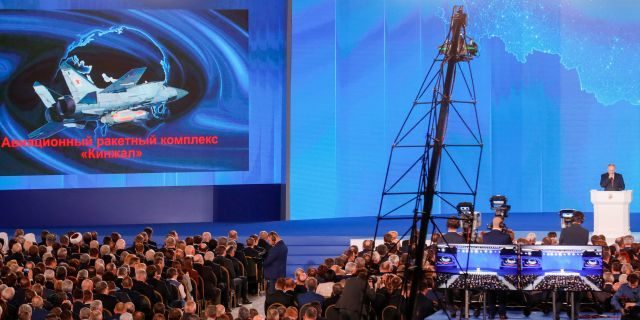
"China and Russia are pursuing hypersonic weapons because their speed, altitude and maneuverability may defeat most missile defense systems, and they may be used to improve long-range conventional and nuclear strike capabilities," the report said. "There are no existing countermeasures."
Earlier this year, the Russian military said it ran a successful test of a nuclear-capable hypersonic missile capable of sneaking through enemy defenses.
A video posted by the Defense Ministry Sunday showed a MiG-31 fighter jet launching a Kinzhal (Dagger) missile during a training flight. The ministry said the missile, which carried a conventional warhead, hit a practice target at a firing range in southern Russia.
Russian President Vladimir Putin said Kinzhal flies 10 times faster than the speed of sound, has a range of more than 1,250 miles and can carry a nuclear or a conventional warhead. The military said it's capable of hitting both land targets and navy ships.
The U.S. military has been busily ramping up its hypersonic weapons capabilities.
In April, the Pentagon announced a deal with Lockheed Martin to develop a "hypersonic conventional strike weapon" for the U.S. Air Force. The deal for the air-launched Hypersonic Conventional Strike Weapon (HCSW) is worth up to $928 million.
Four months later, the Air Force awarded Lockheed Martin a contract of up to $480 million to design a second hypersonic prototype, the Air-Launched Rapid Response Weapon (ARRW).
"The ARRW and HCSW efforts are developing unique capabilities for the warfighter and each has different technical approaches," explained the Air Force, in a statement. "The ARRW effort is 'pushing the art-of-the-possible' by leveraging the technical base established by the Air Force/DARPA partnership. The HCSW effort is using mature technologies that have not been integrated for an air-launched delivery system."
In its response to the GAO, the Department of Defense described the report as "an accurate although sobering macro picture of how the US stands in the world against emerging threats."



Comment: When Putin first announced Russia's new weaponry, the Western media and politicians went into a state of denial, strongly implying that Putin was bluffing and Russia didn't have the capabilities he said they did. Well, Russia does have those capabilities. At least the military is coming around to accepting reality.